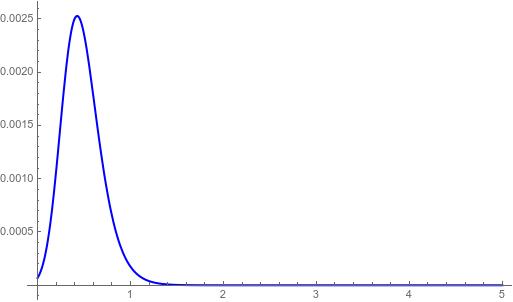We can solve this equation using colocation method and Haar wavelets. There are two branch of solution for every $c0 < 1/2$. For some $\beta, c0$ we can get these branches with code
Get["NumericalDifferentialEquationAnalysis`"];
plot[cc_, bb_, rr_, nn_] :=
Module[{c0 = cc, b = bb, r = rr, n = nn},
M = Sum[1, {j, 0, n, 1}, {i, 0, 2^j - 1, 1}] + 1;
dx = 1/M; A = 0; xl = Table[A + l*dx, {l, 0, M}];
xcol = Table[(xl[[l - 1]] + xl[[l]])/2, {l, 2, M + 1}];
psi1[x_] := WaveletPsi[HaarWavelet[], x];
psi2[x_] := WaveletPhi[HaarWavelet[], x];
psi1jk[x_, j_, k_] := psi1[j*x - k];
psi2jk[x_, j_, k_] := psi2[j*x - k];
psijk[x_, j_, k_] := Sqrt[j]*(psi1jk[x, j, k] + psi2jk[x, j, k]);
np = M; gw = GaussianQuadratureWeights[np, -1, 1];
points = gw[[All, 1]]; weights = gw[[All, 2]];
GaussInt[ff_, z_] :=
Sum[(ff /. z -> points[[i]])*weights[[i]], {i, 1, np}];
u[t_] := Sum[
a[j, k]*psijk[t, 2^j, k], {j, 0, n, 1}, {k, 0, 2^j - 1, 1}] +
a0 + 1/2 + r Sqrt[1/4 - c0];
u[t_] := Sum[
a[j, k]*psijk[t, 2^j, k], {j, 0, n, 1}, {k, 0, 2^j - 1, 1}] +
a0 + 1/2 + r Sqrt[1/4 - c0];
varM = Join[{a0},
Flatten[Table[a[j, k], {j, 0, n, 1}, {k, 0, 2^j - 1, 1}]]];
int1[t_] := (t/
2) GaussInt[(1 + z) u[t/2 (z + 1)] Exp[((-t/2 (1 + z) + t)*b)],
z](*s\[Rule]x/2 (1+z)*);
int2[t_] := (t/
2) GaussInt[(1 + z) u[
t/2 (z + 1)]^2 Exp[((-t/2 (1 + z) + t)*b)], z];
varM = Join[{a0},
Flatten[Table[a[j, k], {j, 0, n, 1}, {k, 0, 2^j - 1, 1}]]];
int1[t_] := (t/
2) GaussInt[(1 + z) u[t/2 (z + 1)] Exp[((-t/2 (1 + z) + t)*b)],
z](*s\[Rule]x/2 (1+z)*);
int2[t_] := (t/
2) GaussInt[(1 + z) u[
t/2 (z + 1)]^2 Exp[((-t/2 (1 + z) + t)*b)], z];
eq = Table[
u[t] - u[t]^2 - b int1[t] + b int2[t] + b u[t] int2[t] - c0 ==
0, {t, xcol}];
sol = FindRoot[eq, Table[{varM[[i]], r/10}, {i, Length[varM]}],
MaxIterations -> 1000];
unum = Table[ {xcol[[i]], Evaluate[u[xcol[[i]]] /. sol]}, {i,
Length[xcol]}]; ListLinePlot[unum]]
Here $u=\epsilon, b=\beta$, $n$ is number of colocation points and $r=\pm 1$ is the indicator of branch. For example, for $c0=-0.5, \beta =0.1$ we have
{plot[-.5, 0.1, -1, 4], plot[-.5, 0.1, 1, 4]}











c0? Or are you looking for an analytical solution? $\endgroup$t==0. Because\[Epsilon][0]==0it followsc0==0! If yes, the fixpointiteration yields\[Epsilon][t]==0! $\endgroup$